
|
Astronomy Picture Of the Day (APOD)
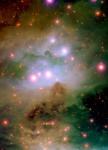 The Colorful Orion Nebula
The Colorful Orion Nebula
14.09.1999
The Great Nebula in Orion is a colorful place. Visible to the unaided eye as a fuzzy patch in the constellation of Orion, this image taken with the Big Throughput Camera shows the Orion Nebula to be a busy neighborhood of young stars, hot gas, and dark dust.
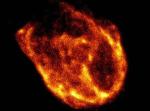 Supernova Remnant N132D in X Rays
Supernova Remnant N132D in X Rays
13.09.1999
Thousands of years after a star explodes, an expanding remnant may still glow brightly. Such is the case with N132D, a supernova remnant located in the neighboring Large Magellanic Cloud galaxy. The expanding shell from this explosion now spans 80 light-years and has swept up about 600 Suns worth of mass.
 Stonehenge: Ancient Monument to the Sun
Stonehenge: Ancient Monument to the Sun
12.09.1999
Stonehenge consists of large carved stones assembled about 4000 years ago. Long before modern England was established, ancient inhabitants somehow moved 25 ton rocks nearly 20 miles to complete it. From similar constructs...
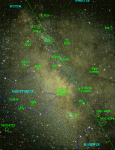 The Annotated Galactic Center
The Annotated Galactic Center
11.09.1999
The sky toward the center of our Galaxy is filled with a wide variety of celestial wonders. Many are easily visible with binoculars. Constellations near the galactic center include Sagittarius, Libra, Scorpius, Scutum, and Ophiuchus. Nebulae include Messier Objects M8, M16, M17, M20 and the Pipe Nebula.
 Cassini Images The Moon
Cassini Images The Moon
10.09.1999
On August 18, the Cassini spacecraft flew by the Earth and Moon, then continued on its way to the outer solar system. Near its closest approach to the Moon, a distance of about 377,000 kilometers, controllers tested Cassini's imaging systems on this most familiar celestial body.
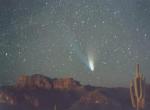 Comet Hale Bopp Over the Superstition Mountains
Comet Hale Bopp Over the Superstition Mountains
9.09.1999
Four years ago, Comet Hale-Bopp was discovered out near Jupiter falling toward the inner Solar System. Two years ago, it provided spectacular pictures as it neared its closest approach to the Sun. Still today, spectacular pictures of the brightest comet of the 1990s are surfacing.
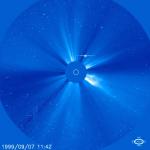 A Superior Conjunction Of Mercury
A Superior Conjunction Of Mercury
8.09.1999
In astronomical parlance, an interior planet is at superior conjunction when it is located on the opposite side of the Sun from Earth. Mercury, the solar system's innermost planet, zips past this point in its orbit today.
 Water Found in Space Rock
Water Found in Space Rock
7.09.1999
What would you do if it rained blue water from space? On 1998 March 22, no umbrella was needed, as the blue water came attached to a stony meteorite that landed in Monahans, Texas. The meteorite fall was seen by several boys, and was being carefully scrutinized by NASA scientists within 72 hours.
 HCG 87: A Small Group of Galaxies
HCG 87: A Small Group of Galaxies
6.09.1999
Sometimes galaxies form groups. For example, our own Milky Way Galaxy is part of the Local Group of Galaxies. Small, compact groups, like Hickson Compact Group 87 (HCG 87) shown above, are interesting partly because they slowly self-destruct.
5.09.1999
Scroll right and watch the universe evolve. Above is a computer simulation depicting the evolution of our entire universe. On the far left is a slice of the universe soon after the Big Bang - over 10 billion years ago.
|
January February March April May June July August September October November December |
|||||||||||||||||||||||||||||||||||||||||||||||||